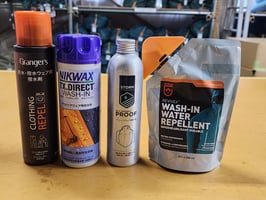DWR and water resistance are often misunderstood. Discover the key differences between DWR and...
Waterproof vs Water repellent vs Water resistant
Surprisingly few people can properly explain the difference between waterproofing and water repellency.
Even in mountaineering equipment and home centers, products with only water-repellent effects are often sold as waterproofing agents, and even websites often provide incorrect explanations. Therefore, many people seem to be mistakenly aware of this.
For example, one website stated that the products are stronger in the order of water resistance, water repellency, and waterproofing. This is a completely incorrect explanation. While there are some definitions of the terms, they refer to different physical phenomena in the first place.
In this article, we will explain the difference between waterproofing and water repellency, as well as water resistance.
What is water repellency?
It is a phenomenon that repels water. In the case of oil, it is also expressed as oil repellency. In general, the phenomenon of repelling liquid is often expressed as water repellency.
The key point is that it is described as a phenomenon. A phenomenon can be said to be the appearance of a thing in a certain form. As in the expression "a mysterious phenomenon occurs," we use the word "phenomenon" when something tangible happens.
For example, let's say you spill water on a table. At this time, the sight of water spreading on the table will somehow come to your mind's eye. I don't think many people would describe this as "water repellent.
Now let's say rain falls on the rain jacket or umbrella you just bought. The water would roll off in a sphere. I think it would make sense to describe this state as "water repellent.
What is the difference between the above? When water touches something, if it is not absorbed by something like a sponge, it has a contact angle. The contact angle can take from 0° to 180°.
Wikipedia has an easy-to-read diagram of the contact angle. In this case, the C and S diagrams are less than 45°, which is not very water repellent. According to some literature, an angle of 90° or more is considered water repellent, while an angle of less than 90° is considered wet (hydrophilic). It is difficult to clearly define the definition of water repellent from an angle of any degree, but when the contact angle has a certain degree, it is described as water repellent.
Incidentally, a contact angle exceeding 150° is called super water repellent.
What is waterproof?
Waterproof refers to a function that prevents water from entering.
You may be thinking, "Isn't it OK to call a phenomenon in which water does not get in water waterproof? You may think so. However, in many cases, just as you would not call a piece of steel, for example, waterproof, waterproofing is basically the process of preventing water from entering or passing through an object that would normally allow water to enter by applying a certain device to it. Therefore, waterproofing is defined as a function to prevent water from entering.
If waterproofing is applied to a fabric, a waterproof fabric is one that does not allow water to enter even if it is subjected to a certain degree of pressure. For example, this fabric is expressed as having a waterproof performance of 1000 mm. The higher the number, the more waterproof the fabric is.
If it is a machine, a waterproof device is one that is designed so that the machine will not break even if it is splashed or dropped into water. In the case of machines, there is a waterproof rating called IPX, which is expressed as IPX7. The higher the number, the higher the waterproof performance, with the maximum value being IPX8.
Are waterproofing and water repellency different terms, a phenomenon or a function?
Water repellency is a phenomenon that repels water, while waterproofness is a function that does not allow water to pass through, but waterproofness and water repellency are not just different phenomena or functions. They are completely different physical phenomena.
Let me explain about fabrics.
Waterproof fabrics are laminated or coated with a membrane to prevent water from passing through. The performance of the membrane or coating determines how much pressure is applied to the fabric to prevent water from passing through, but in each case, the fabric blocks the gaps that allow water molecules to pass through, thus preventing water from passing through.
Water repellency, on the other hand, differs from them. Water repellency is the force of water itself. If no force is applied to water, it tries to curl up. You may have seen water droplets floating in space on film. Water tries to become a round mass. This is actually the source of water repellency.
As I explained about contact angle when I explained water repellency, when water touches something, there is a force of attraction between the water and the thing it touched. This is true for tables, car bodies, glass, and vinyl. At this time, the force of attraction between water and the object it touches differs depending on the object. If the force of attraction is strong, the water tries to spread out. If the force of attraction is weak, and even weaker than the force of the water trying to form a circle, the water tries to form a puddle on the touched object. When this happens, we call the water repellent. In other words, water repellency is the force of water itself.
Therefore, waterproofing and water repellency are different physical phenomena and do not refer to the same phenomenon. We do not call something weakly waterproof water repellent.
Then, what is water resistance?
Another similar term is water resistance. Some websites explain that the order of resistance to water, water repellency, and waterproofing increases in that order, but this is by no means the case.
For example, there is no standard for water-resistant fabrics. There are ISO and JIS tests for waterproofness and water repellency, and fabrics that have been measured are called waterproof fabrics or water repellent fabrics. On the other hand, there is no test standard for water-resistant fabrics.
In terms of language, water-resistant refers to the ability to withstand water, so I think it can be said to refer to a wider range of conditions than just waterproofing. For example, a waterproof jacket has seam tape to prevent water from entering the seams. On the other hand, there are jackets that do not require that level of waterproof performance and use waterproof fabric but do not have waterproof tape at the seams. These are not waterproof jackets, but they can be called water-resistant jackets. A jacket that does not lose its functionality when exposed to water can be broadly considered water-resistant.
Another test to measure waterproof performance is the water pressure resistance test. Since resistance to water can be expressed as water resistance in general, the test to measure waterproof performance is also measured from the perspective of how much pressure it can withstand, and is referred to as water pressure resistance.
Waterproofing and Water Resistance Standards for Equipment
Unlike fabrics, there are standards corresponding to water resistance standards for equipment. IP stands for "ingress protection," so standards are determined separately for ingress of sand, dust, and other solid objects, and for ingress of water. IPX00 to IPX08 are available for water, and the higher the rating, the more waterproof and water-resistant the product is. The higher the rating, the more waterproof or water-resistant the product.
Other standards where water resistance is used
For example, in the case of cosmetics, there is a water resistance test specified by ISO. This test is designed to determine whether the function of cosmetics can be maintained even when exposed to water, and only the term "water-resistant" applies to this test, not "waterproof" or "water-repellent".
Conclusion
In this article, we have explained the difference between waterproofing and water repellency from a physical aspect. I also explained the difference between waterproof and water-repellent.
We hope you now understand that waterproof does not equal water repellent.
Therefore, it is possible to have a product that is waterproof but not water-repellent, or to have a product that is water-repellent but not waterproof.
Please keep in mind that it is quite possible for one or the other to occur, as they are different physical phenomena.


.jpeg?height=200&name=AdobeStock_16741486(1).jpeg)

